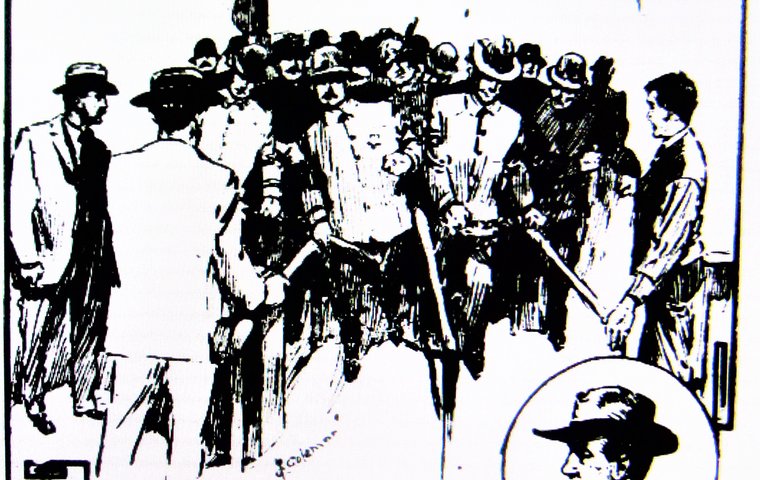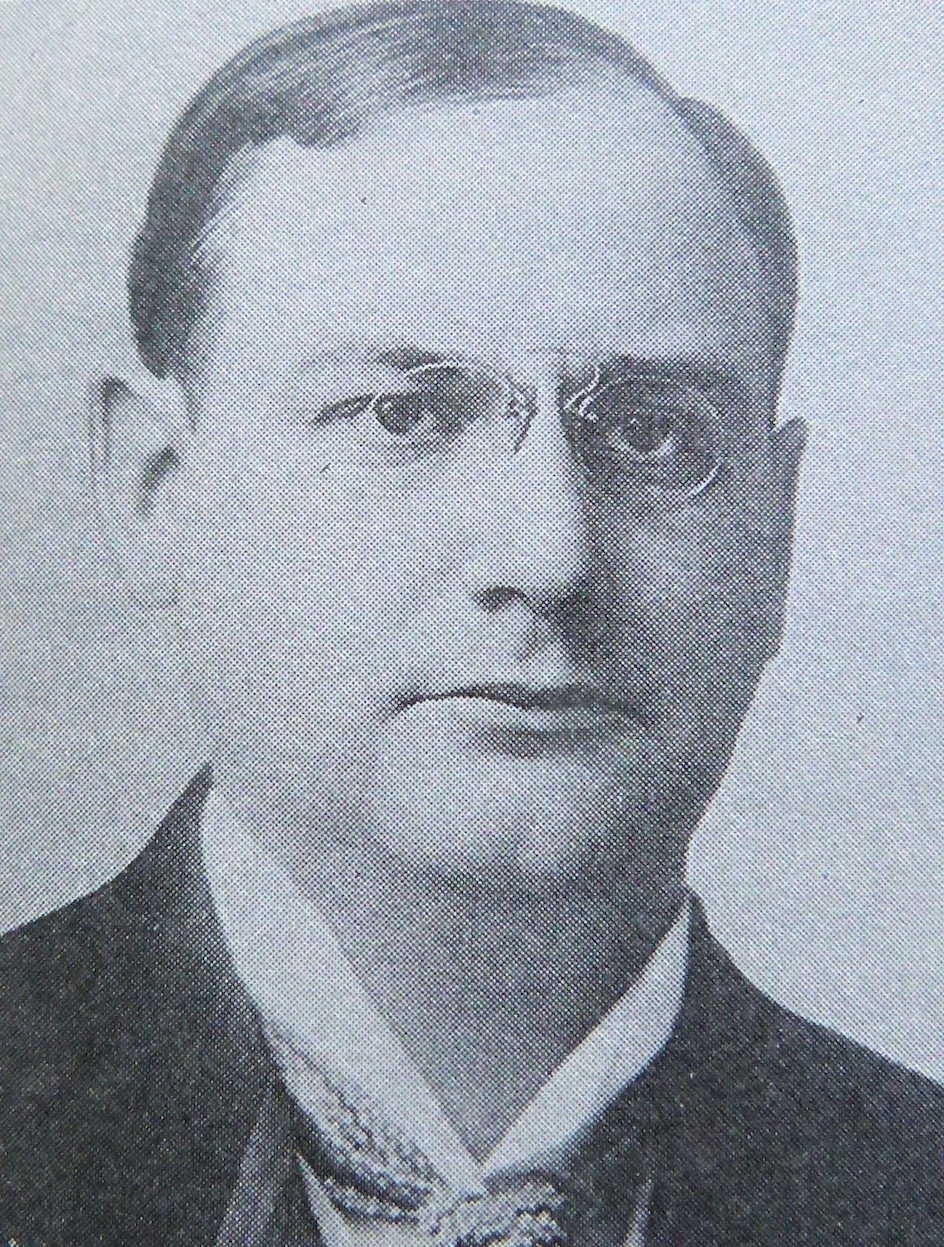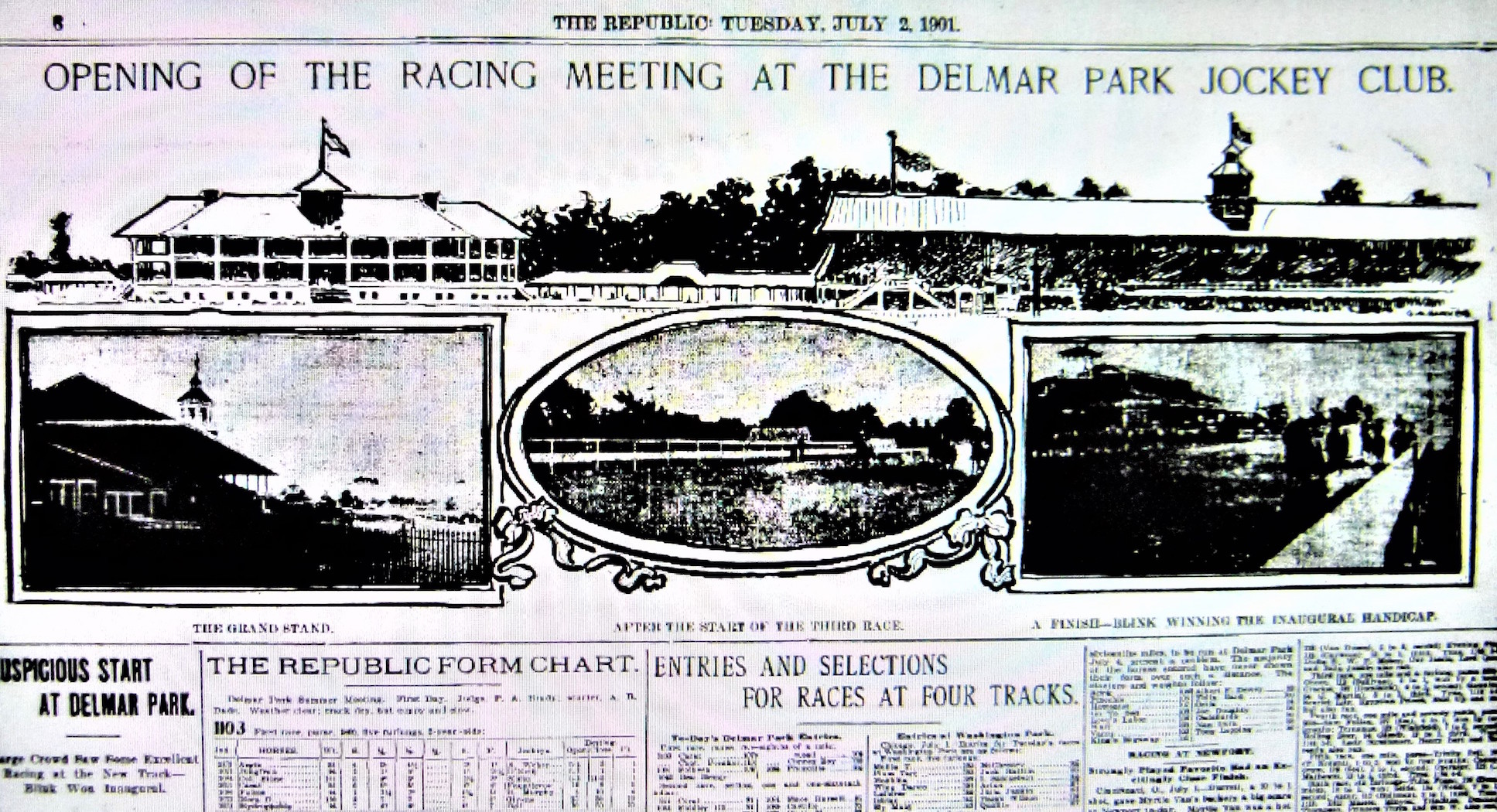
The name Del Mar evokes images of a picturesque seaside resort, ‘where the turf meets the surf’. Long before that venue debuted in 1937, there was another track bearing the same name, this one located nowhere near a beach. Its short but colourful history has been all but forgotten.
Horse racing in Missouri goes back a long way, to the 18th century, and history was made in its largest city, St Louis, on June 20, 1892, when the South Side track became the first to conduct a meeting under electric lights. During that same era, St Louis even had a track running along the outer perimeter of a baseball park.
A few of the smaller St Louis tracks at the time raced at night and in the winter, which was dismissed, especially in the papers, as considerably more downmarket than summer racing, attracting a less desirable element than its summer counterpart, the main focus thought to be more on gambling as opposed to sport and society.
In 1897, the Breeders’ Law was passed in Missouri, putting an end to night racing and limiting racing at each track to 90 days a year between April 15 and November 1. It was so named because a group of owners and breeders in the state, concerned that racing might be halted by the state legislature, drafted their own bill to regulate the sport.
The law was challenged in court repeatedly, but it was finally declared constitutional by the Missouri supreme court in 1901. However, the law didn’t restrict how many tracks could be owned by a single entity.
Delmar Park was owned by the CAT syndicate, made up of three men: Louis Cella, whose nephew John and great nephew Charles were the respective founder and operator of Oaklawn Park in Arkansas, Samuel Adler and Andrew ‘Cap’ (short for ‘captain’) Tilles.
The syndicate had purchased a controlling interest in the St Louis Fair Grounds track in 1900 and the same year purchased land to build another track, which would become Delmar.
A 1902 ad in the St Louis Post-Dispatch for the annual agricultural fair held at the Fair Grounds promised ‘racing all week on a one-mile track’ and such attractions as ‘performing seals and sea lions, a daring balloonist, a wonderful high wire act and a one-legged trick cyclist’.
Held at a different venue from the aforementioned fair, in 1904 St Louis hosted a World’s Fair alongside the Summer Olympic Games. To commemorate the event, the Fair Grounds track hosted the $50,000 World’s Fair Handicap (a phenomenal sum, considering that year’s Kentucky Derby was worth only $6,000). It was won by Colonial Girl, a 5-year-old locally owned and trained daughter of leading sire Meddler, who beat the heavy favorite Hermis, with the 1903 Kentucky Derby winner, Judge Himes, back in 11th.
Delmar was located in the Delmar Loop area of St Louis and named for one of the streets that bordered it. The name was reportedly a combination of Delaware and Maryland, the home states of a couple of the street’s residents.
The track opened on July 1, 1901. It didn’t take long for trouble to start brewing.
In August, the Missouri attorney general declared that Delmar and the Fair Grounds were to be considered a single entity as they were under the same ownership, entitling them to only 90 days’ racing under the law. Later that month, bookmakers’ licenses at Delmar were revoked as the attorney general alleged that the licences had not been properly issued and were “surreptitiously obtained”, thus rendering them void.
A temporary injunction was issued against the track officials at the beginning of September to prevent bookmaking there. A court order was received and promptly ignored. The track’s bookmakers were ordered to appear in court. Track officials, taking advice from their attorneys, refused to accept service of the citations for contempt issued against them with the bookmakers saying the judge’s jurisdiction didn’t extend beyond the city limits.
Alligator attack
This all came about because, curiously, the city of St Louis was an ‘independent city’, lying outside St Louis county, the city having split from the county in 1877, and the track was located predominantly in St Louis county. The question was who had jurisdiction over the track. Delmar eventually won the case, but the issue would rear its head again only a few short years later.
In July 1903, a young bookmaker who worked at Delmar, Nathaniel Moore, was attacked by a small alligator that was on exhibition at the nearby Delmar Gardens amusement park. He reached his hand out, assuming the animal was stuffed, but found otherwise when the critter crushed his right forearm.
Come the beginning of 1905, the bookies at Delmar would find themselves facing an even more formidable foe than any gator.

The number of articles and intensity of criticism grew towards the end of 1904, just as Folk was about to be inaugurated. All the same, the paper continued to cover racing, printing entries and results and taking advertising from the tracks.
Once in office, Folk immediately jumped on his moral high horse and vowed to put a stop to gambling in the state. Opposition snowballed, fuelled by the paper’s negative coverage and gathering momentum from religious groups.
There was likely a political as much as a moral element involved. The Post-Dispatch being very much a Democratic organ and the CAT syndicate made up of Republicans.
Folk’s efforts were successful in that an act repealing the Breeders’ Law went into effect on June 17, 1905, but Delmar continued racing, declaring it would not be responsible for any betting and that its sole remit was in conducting races. The new law made betting on horse racing in Missouri a felony punishable by imprisonment, specifically prohibiting the recording or registering of bets. This was circumvented by the Delmar bookies by a system where bettors were identified by the number on their admission badge.
‘A sore spot in Missouri’s side’
One arrest was made at the track that day, bookmaker George Erlich, on a charge of violating the new law. He was released on $1,000 bond.
The following day, the governor gave orders to St Louis County Sheriff George Herpel to stop all betting at Delmar “no matter what cost”, declaring that the militia would be called out if necessary.
Sheriff Herpel responded: “I am against raids in the practical meaning of that term, which means a seizure of persons or property without legal process of law or evidence of any violation of law.”
Governor Folk, who may well have been egged on by the paper’s anti-gambling campaign, retorted, “Missouri is the most law-abiding state in the Union, but St Louis county just now is a sore spot in Missouri’s side.”
On June 20, three arrests were made at Delmar by St Louis county deputy sheriffs, including Erlich for a second time. There were three more arrests on the 23rd and two more the following day. All were released on bond.
That evening, Herpel issued a statement, obviously directed at the governor: “An appeal to bayonets is the first threat of a bigot fired by fanatical zeal to further his personal ambition and ideas against the guaranteed liberties of the people.” He went on to state that he had not requested any assistance from the governor. “Troops will not be sent into this county legally until I have made such a request.”
Then he made a not very veiled threat. “If troops come in here, they are liable to be shot. I do not say that the sheriff or the sheriff’s deputies will be responsible for the shooting, but some of the citizens around here might not like the idea of sending in soldiers.”
Attorney General Herbert Hadley told Folk it was a “waste of effort” to try to persuade the county sheriff to raid the track. Folk considered using the city police, but the AG encouraged him to consider bringing in the militia. “The fact remains that an organized gang of outlaws is daily committing felonies under the noses of these officials and they are doing nothing about it,” declared Folk. “Since the local officials will not enforce the laws, other steps must be taken.”
For the remainder of June and the first part of July it was business as usual at Delmar, with Herpel and his deputies showing up at the track daily. Herpel indicated that, unless what wagering was going on became more open, there would be no arrests.
The Post-Dispatch wrote a “scathing” article about Louis Cella on July 20 after he ejected a reporter from that paper from the track the day before, while the paper continued to cover racing on its sports pages.
That same day, Sheriff Herpel received orders from Folk to stop the betting at Delmar. The Sheriff sent deputies to the track, but, according to reports, they didn’t stop any gambling, choosing instead to spend the time at the bar “enjoying the hospitality of the genial track owners” as the gambling “went merrily on in the betting ring just outside, but beyond the ken of the minions of the law”.
Plan to block the runners
Folk, meanwhile, had issued orders to the militia to be held in readiness to be called out. He was “not greatly surprised” that gambling was still taking place, but said he would give Sheriff Herpel “one more chance to enforce the law”. Two detectives, on Folk’s orders, were placed at the track to gather evidence. His plans were interesting, to say the least.
Once enough evidence had been gathered, the governor planned to order the police out to the track “to be stationed across that part of the track which lies within the city limits. When the horses reach that point in a race the police will be drawn across the track and will arrest every jockey in the race”.
How that would work with the field galloping full tilt straight at them is uncertain.
The governor issued orders for a police detail to be stationed daily at the track. He sent a letter to the president of the St Louis city police saying “a state of lawlessness exists” in the county and that local officials “either cannot or will not uphold the laws there”.
On the 21st, a lone deputy sheriff turned up at the track, spending most of his afternoon at the bar. The St Louis Republic noted, “The usual sprinkling of women was present, but they did not appear to speculate on the races.”
That casual atmosphere was shattered on Saturday, July 22, when A C Stewart, president of the police board, police chiefs Mathew Kiely and William Desmond and 32 patrolmen, two sergeants, one captain, 12 mounted police and an assortment of detectives raided the track. The raid was supposed to commence at 3 pm, but the cops didn’t arrive at the track’s entrance until four.
The track was ready
Rumors of a raid had circulated the day before, and track officials were ready for it, with track stewards scanning the grounds with their binoculars. Once the cops were sighted, a bell was rung in the grandstand to signal their arrival, alerting the spectators and bookies.
Stewart, Kiely, Desmond, the detectives and police Captain George McNamee proceeded to the track gates.
Samuel Adler approached the men and asked if they had admission tickets. Kiely replied, “No, but …”
Adler responded: “Well, you’ll have to get them before you can get in.”
The men lined up and bought tickets, at one dollar each, then entered the track.
Stewart and Kiely read a letter from the governor to Adler, then Adler escorted them to the betting ring, where no betting was observed. In what must have been the most benign raid ever conducted, the group watched the last race. The police left, followed by the rest of the party. It was all very civilized.
That wasn’t the end of it, however. On Monday July 24, 85 police, under the command of Captain McNamee, broke down the barriers after admission had been refused by track officials and invaded the betting ring.
Constable Fred Lenz attempted to serve warrants for the arrest of McNamee and 17 St Louis policemen for trespass. As the constable began to read the warrant, McNamee and his officers walked away from him. The constable tried again 15 minutes later. With a crowd of spectators gathered, McNamee told the constable to “Go away”. Lenz was then jostled out of the way by McNamee’s men.
Police invasion
Later a second and third police detail arrived and lined up with the others in the betting ring. The invasion was brought about after track officials twice refused to grant admission to four detectives earlier in the afternoon.
The races were run as scheduled in front of a crowd of citizens and police. No one was seen taking any bets and no one was arrested. When the last race had been run, everybody left. The scenario was nothing short of farcical.
After the last race, the police were given the order to march out.
“Tramp, tramp, tramp, the boys are marching,” one track employee sang.
“Come back tomorrow, boys,” another called out derisively.
The next day, the Delmar Jockey Club filed suit in the St Louis Circuit Court for $25,000 in damages against the governor and chief of police, among others, alleging trespass in light of the previous day’s raid and challenging the authority of the city police over the track. In December, the suit was dismissed.
Three of the bookmakers who had been arrested were found not guilty at 11 pm that night.
Eleven more were arrested in the betting ring the next day after the police again forced their way in. This time they included ten officers with riot guns. To prove that private betting wasn’t illegal under the new law, Louis Cella placed a $200 bet in front of Captain McNamee. The bookies were taken away in patrol wagons.
Private wagering
One bookmaker, when asked his line of business by a police sergeant, replied, “I guess you’d call me a bookmaker, but I haven’t been doing much in that line lately.” Another gave his occupation as “capitalist”. The scene was repeated the following day, with two more arrests made.
On Thursday the 27th, 52 city cops “stormed” the gates after the usual ritual of applying for admission and being refused. The men unlatched the gates and pushed their way in with only token resistance from the gate man and occupied their usual spot in the betting ring. Plainclothesmen went through the crowd looking for evidence of betting but only found private wagering, which continued without interference.
Then on Thursday evening a decision was handed down by Missouri Supreme Court judge William Marshall stating the governor had the authority to send the St Louis city police into any county of the state to suppress “outlawry” and, when sent by the governor, they were superior to local officers and couldn’t be arrested in the discharge of their duties.
In other words, the county officials had no power to interfere with or prevent the city police from enforcing the law and, under the governor’s order, the city police would continue to raid the track.
Anyone arriving at the track on the 28th for a day’s racing was met with a notice on the gates stating there would be no racing until further notice. The police arrived as usual and, finding the ticket office closed and no one on the gates, waited until the time for the first race passed with no activity, then left. That was the end of Delmar Park. All of the bookmakers who had been arrested were acquitted.
Fairmount fills the void
The track fracas was deemed the latest manifestation of Folk’s “militia spasms” with the governor attempting to enforce laws no one had bothered with in years, including one requiring saloons to close on Sundays.
Folk had been quoted as saying, “There has been entirely too much making of laws to please the moral element and then allowing the laws to be ignored to please the immoral element.”
Limited by law to serving one four-year term as governor, Folk went on to serve in President Woodrow Wilson’s administration as solicitor general of the State Department, then resumed a private law practice in Washington DC.
The track’s closure spelled the end of horse racing in Missouri, but the St Louis area wasn’t without a track for long. Fairmount Park, just across the Mississippi from St Louis in Illinois, opened in 1925 and continues to hold racing between April and September.
While the troops were never actually called out to Delmar, on two subsequent occasions the militia would be brought in to put a stop to racing, in 1912 at Mineral Springs in Indiana and in 1937 at Narragansett Park in Rhode Island. Those tracks, along with Delmar, are now long gone.
Sources
Chicago Tribune, July 5, 1903
Daily Racing Form, various dates, July – October 1901
Hoofprints of the Century, William Robertson and Dan Farley, The Thoroughbred Record, 1975
Making Tracks, The Untold Story of Horse Racing in St Louis, 1767-1905, Nancy E. Carver, Reedy Press, 2014
New York Times, June 24, 1905
St. Louis Republic, various dates, 1905, Library of Congress Chronicling America website
Trouble at the Track, David Linzee, April 20, 2012, patch.com
Washington Post, June 17, 1905



